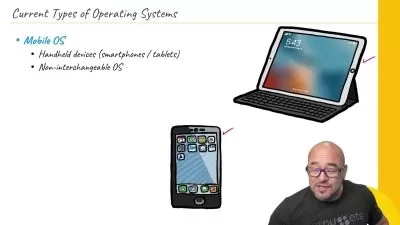Build an 300 lines Operating System From Scratch (x86 base)
Min Jiang
4:43:20
Description
How to Create an x86 Operating System Using QEMU Virtualization Software, Assembly, and C code.
What You'll Learn?
- you will learn operating system coding concepts.
- how to setup tools/environment in windows to develop an operating system.
- how to run all the examples code.
- x86 cpu computer booting process.
- x86 cpu assembly programming model.
- interrupts and timers.
- basic scheduling.
- memory mapping, what it is, and how it works.
- what is system call, and how to implement them.
- how does paging system work. how to implement it.
- how to create tasks in system prospective.
- what work the hardware does and what work does software is responsible for.
Who is this for?
More details
DescriptionThis course will cover both theoretical operating system (OS)Â concepts and their practical application. We will first introduce the OS concepts which will then be directly applied to the development of our 300-line mini OS. You will learn about both hardware and software responsibilities from the CPUÂ boot process to scheduling, interrupts, timers, system calls, memory mapping, paging, etc.
I struggled a lot myself when learning some of these concepts for the first time in college. It was always hard learning about operating system theory in textbooks without a source code reference. Despite being very interested in the topic, I was not successful in internalizing these concepts the first time around as I didn't have a live example to meddle with and actually see running. This is my motivation for this course - to provide learners with what I myself did not have.
I hope you all enjoy the instruction. I would very much appreciate any feedback you may have or suggestions on topics for further content. The best way to help me is to leave a review and share the class link with your friends. I'm currently planning to succeed this course with one on how to fully understand Linux kernel source code (v0.11.0).
Q&A:
Your feedback is always welcome! Once you register my class, you will see my email address at the top of each source code file. Please send me an email. You can also make an appointment for the Zoom Q&A meetings on the weekends to let me know your thoughts or raise any questions on the material. Happy to meet you guys.
Who this course is for:
- college students/new graduates.
- recent graduates with 1-2 years experience.
- high-level language developers (python, java, app developers).
- java script/web developers.
- professionals and technology enthusiasts who are interested in gaining practical hands-on experience to more deeply understand how a computer's operating system works.
- job seekers interested in embedded software roles at tech companies (i.e. Google, Amazon, Apple, etc…).
- anyone is interested in operating system programming.
This course will cover both theoretical operating system (OS)Â concepts and their practical application. We will first introduce the OS concepts which will then be directly applied to the development of our 300-line mini OS. You will learn about both hardware and software responsibilities from the CPUÂ boot process to scheduling, interrupts, timers, system calls, memory mapping, paging, etc.
I struggled a lot myself when learning some of these concepts for the first time in college. It was always hard learning about operating system theory in textbooks without a source code reference. Despite being very interested in the topic, I was not successful in internalizing these concepts the first time around as I didn't have a live example to meddle with and actually see running. This is my motivation for this course - to provide learners with what I myself did not have.
I hope you all enjoy the instruction. I would very much appreciate any feedback you may have or suggestions on topics for further content. The best way to help me is to leave a review and share the class link with your friends. I'm currently planning to succeed this course with one on how to fully understand Linux kernel source code (v0.11.0).
Q&A:
Your feedback is always welcome! Once you register my class, you will see my email address at the top of each source code file. Please send me an email. You can also make an appointment for the Zoom Q&A meetings on the weekends to let me know your thoughts or raise any questions on the material. Happy to meet you guys.
Who this course is for:
- college students/new graduates.
- recent graduates with 1-2 years experience.
- high-level language developers (python, java, app developers).
- java script/web developers.
- professionals and technology enthusiasts who are interested in gaining practical hands-on experience to more deeply understand how a computer's operating system works.
- job seekers interested in embedded software roles at tech companies (i.e. Google, Amazon, Apple, etc…).
- anyone is interested in operating system programming.
User Reviews
Rating
Min Jiang
Instructor's Courses
Udemy
View courses Udemy- language english
- Training sessions 13
- duration 4:43:20
- Release Date 2023/02/06











